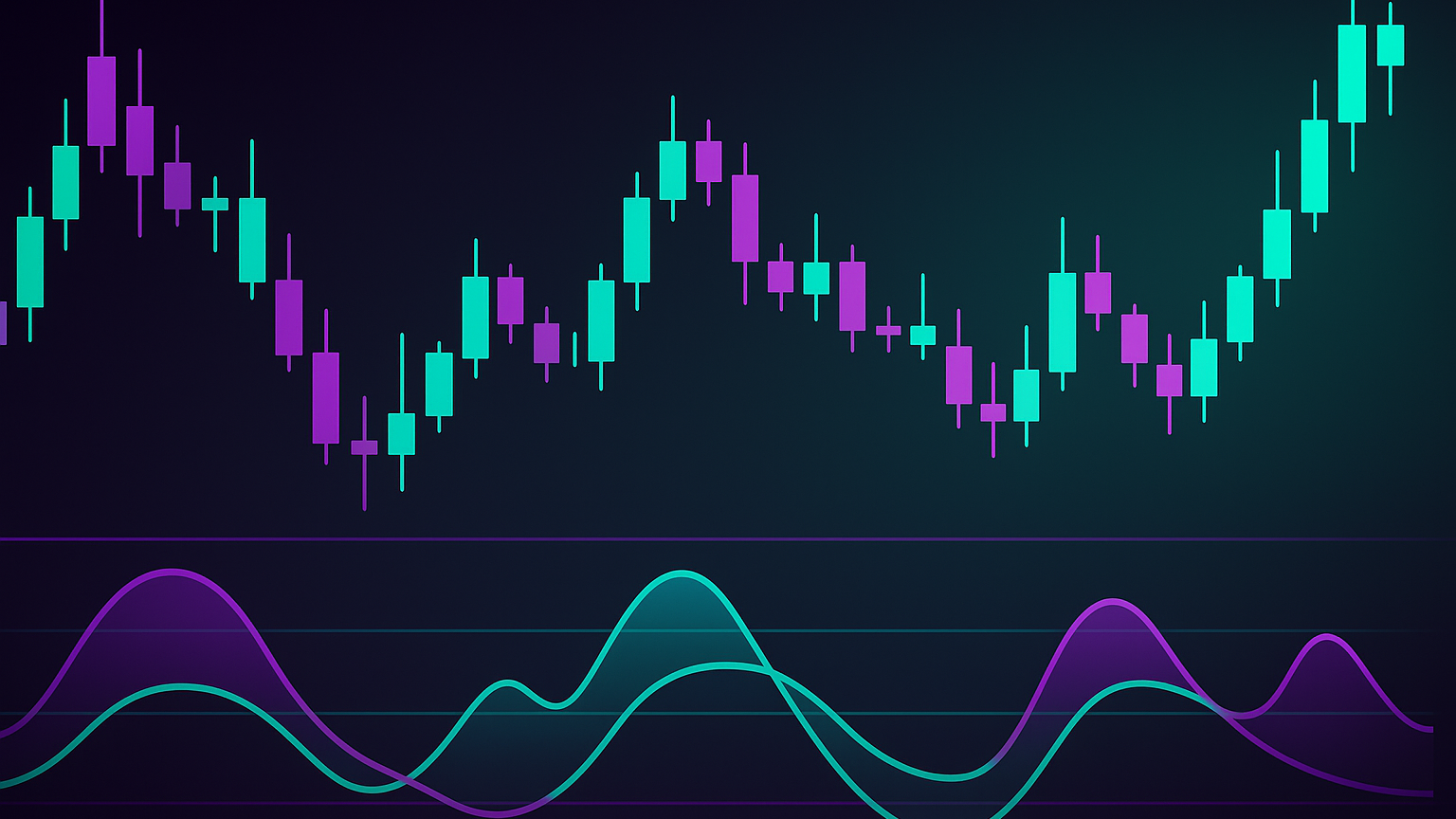Learn how 3-Method formations can help you identify and trade trend continuations in the market with clear entry and exit strategies.
3-Method formations are candlestick patterns that help traders identify trend continuations in the market. They signal whether an uptrend (bullish) or downtrend (bearish) is likely to persist, making them useful for timing trade entries and exits.
Key Points:
- Structure: A large trend-following candle, three smaller counter-trend candles, and a final large trend-confirming candle.
- Types:
- Rising 3-Methods: Appears in uptrends, confirms bullish continuation.
- Falling 3-Methods: Appears in downtrends, confirms bearish continuation.
- Best Practices:
Quick Overview:
| Pattern Type | Key Features | Trade Signal |
|---|---|---|
| Rising 3-Methods | Bullish candle → 3 small bearish candles → Bullish candle | Buy above final candle |
| Falling 3-Methods | Bearish candle → 3 small bullish candles → Bearish candle | Sell below final candle |
These patterns are most reliable when combined with other tools like trend analysis and volume confirmation. Read on to learn how to spot, validate, and trade them effectively.
How to Trade the Falling Three Methods Pattern
Types of 3-Method Patterns
The 3-Method patterns come in two forms, both indicating a continuation of the current trend. Let’s break down their structure and key details.
Rising 3-Methods Pattern
This pattern appears during uptrends and signals ongoing bullish strength:
- A large bullish candlestick that reflects strong upward movement.
- Three smaller bearish candlesticks showing a brief consolidation phase.
- A final bullish candlestick that closes above the first candle's high, confirming the uptrend.
Falling 3-Methods Pattern
This pattern occurs in downtrends and indicates continued bearish momentum:
- A large bearish candlestick that shows strong downward pressure.
- Three smaller bullish candlesticks representing temporary consolidation.
- A final bearish candlestick that closes below the first candle's low, confirming the downtrend.
Pattern Components
Both patterns share a similar structure, as shown below:
| Component | Rising 3-Methods | Falling 3-Methods |
|---|---|---|
| Initial Candle | Large bullish candlestick | Large bearish candlestick |
| Middle Candles | Three small bearish candles within the first candle's range | Three small bullish candles within the first candle's range |
| Final Candle | Bullish close above the first candle's high | Bearish close below the first candle's low |
| Trend Context | Forms in an established uptrend | Forms in an established downtrend |
The three smaller middle candlesticks highlight a short-lived pause in the trend, emphasizing that the counter-move is temporary.
When analyzing these patterns, pay attention to their position within the trend and overall context, rather than focusing solely on the colors of the candlesticks.
Pattern Recognition Guide
Learn how to spot 3-Method formations by focusing on key candlestick patterns and understanding the market context. Here's a practical guide to help you identify these patterns.
Finding Rising 3-Methods
To spot a valid Rising 3-Methods pattern, look for these key features:
| Component | Key Characteristics | Validation Tips |
|---|---|---|
| Market Context | Clear uptrend | Check for higher highs and higher lows |
| First Candle | Large bullish candlestick | Should stand out compared to other candles |
| Middle Candles | Three small bearish candlesticks | Must stay within the range of the first candle |
| Final Candle | Strong bullish close | Must break above the high of the first candle |
Make sure the middle candles reflect consolidation rather than strong selling pressure.
Finding Falling 3-Methods
To identify a Falling 3-Methods pattern, watch for these conditions:
| Component | Key Characteristics | Validation Tips |
|---|---|---|
| Market Context | Clear downtrend | Look for lower lows and lower highs |
| First Candle | Large bearish candlestick | Should dominate the price action |
| Middle Candles | Three small bullish candlesticks | Must stay within the range of the first candle |
| Final Candle | Strong bearish close | Must break below the low of the first candle |
Pay close attention to ensure the middle candles signal a pause in the trend rather than a reversal.
Pattern Recognition Mistakes
- Misreading the Trend Context: Always verify that the pattern forms within a well-defined trend.
- Premature Confirmation: Avoid acting before the fourth candle closes to ensure the pattern is complete.
- Size Misjudgment: The first and last candlesticks should be noticeably larger than the three middle candles.
For better results, combine these patterns with other technical tools like moving averages or momentum indicators to confirm trend continuation before making a move.
Trading with 3-Method Patterns
Once you've identified a 3-method pattern, it's time to put your trading plan into action.
Trade Entry and Exit Rules
Start by waiting for the final candle to close. Enter the trade when the price moves in the expected direction.
| Trade Component | Bullish Pattern | Bearish Pattern |
|---|---|---|
| Entry Timing | After the final bullish candle | After the final bearish candle |
| Confirmation | Price breaks above the final candle's high | Price breaks below the final candle's low |
From there, focus on managing your risk to protect your investment.
Risk Control Methods
Use these strategies to manage your risk effectively:
- Position Sizing: Keep your trade size to 1–2% of your total account balance.
- Stop-Loss Placement:
- For bullish patterns, set your stop-loss just below the low of the fourth candle.
- For bearish patterns, place it just above the high of the fourth candle.
Adjust your stop-loss distances based on market volatility, but always ensure your overall risk remains within 1–2%.
Using Technical Indicators
Once your risk is under control, use technical indicators to confirm the trade setup:
| Indicator | Purpose | How to Use |
|---|---|---|
| Volume | Gauge trend strength | Look for rising volume on the final candle |
| RSI | Check momentum | Use a 14-period RSI to confirm the trend |
| MACD | Verify trend direction | Ensure the MACD line aligns with the expected price move |
Pattern Examples
Take a closer look at trading scenarios involving 3-method formations.
Past Trading Examples
In February 2024, Netflix (NFLX) showcased a classic rising 3-method formation. This setup included a strong bullish candle, three smaller bearish candles consolidating within the range, and a final bullish candle closing above the first candle's high. This signaled further upward momentum, supported by increasing volume.
However, even well-formed patterns can result in mistakes if not handled properly.
Common Trading Mistakes
Here are some frequent errors traders make and how to avoid them:
| Error Type | Impact | How to Avoid |
|---|---|---|
| Misreading the Trend | Leads to false signals in uncertain markets | Always confirm a clear trend before acting |
| Acting Too Early | Higher chances of losses | Wait for the pattern to fully form and confirm |
| Ignoring Key Levels | Poor entry or exit decisions | Include support and resistance levels in your analysis |
Daily Trading Setup
Using these insights, let’s explore a daily trading setup example.
A trader spotted an Upside Gap Three Methods pattern in Cellectis S.A. and entered at $16.39. They set a stop-loss just below the first candle's low at $15.75.
For daily trading, combine patterns with these tools for better confirmation:
| Tool | Use Case | Benefit |
|---|---|---|
| Moving Averages | Identifying trend direction | Confirms the overall market trend |
| Volume Analysis | Assessing pattern reliability | Ensures strong market participation |
| RSI | Checking momentum | Helps evaluate if the trend is likely to continue |
These examples highlight the importance of accurate pattern identification and disciplined trade execution, aligning with earlier recommendations.
Summary
Understanding 3-method formations requires focusing on pattern recognition and disciplined execution to ensure trading success.
Main Takeaways
The success of 3-method formations hinges on recognizing patterns correctly and executing trades with precision. Here are the key elements:
| Component | Key Points | How to Apply |
|---|---|---|
| Pattern Structure | Large initial candle, three smaller opposing candles, final confirming candle | Ensure candles follow this structure |
| Trend Context | Clear, established trend direction | Verify the trend is strong and consistent |
| Risk Management | Strategic stop-loss placement | For bullish setups, place stops below the fourth candle's low; for bearish setups, above the fourth candle's high |
| Confirmation Tools | Use indicators like Volume, RSI, and MACD | Combine multiple indicators for accuracy |
Implementation Steps
Apply these steps to put the 3-method formation strategy into action:
-
Pattern Identification
Look for a complete formation: a large initial candle, three smaller opposing candles within its range, and a final strong confirming candle. -
Entry Strategy
Enter the trade after the final candle closes and confirms the pattern. For rising three methods, ensure the pattern isn't positioned below major resistance levels, leaving room for upward movement. -
Risk Control
Use clear stop-loss levels to manage risk based on your trading style:Risk Level Stop-Loss Placement Best For Conservative Below the low of the first large candle Traders who prefer more caution Moderate Below the low of the second small candle Swing traders Aggressive Below the low of the confirming candle Day traders








